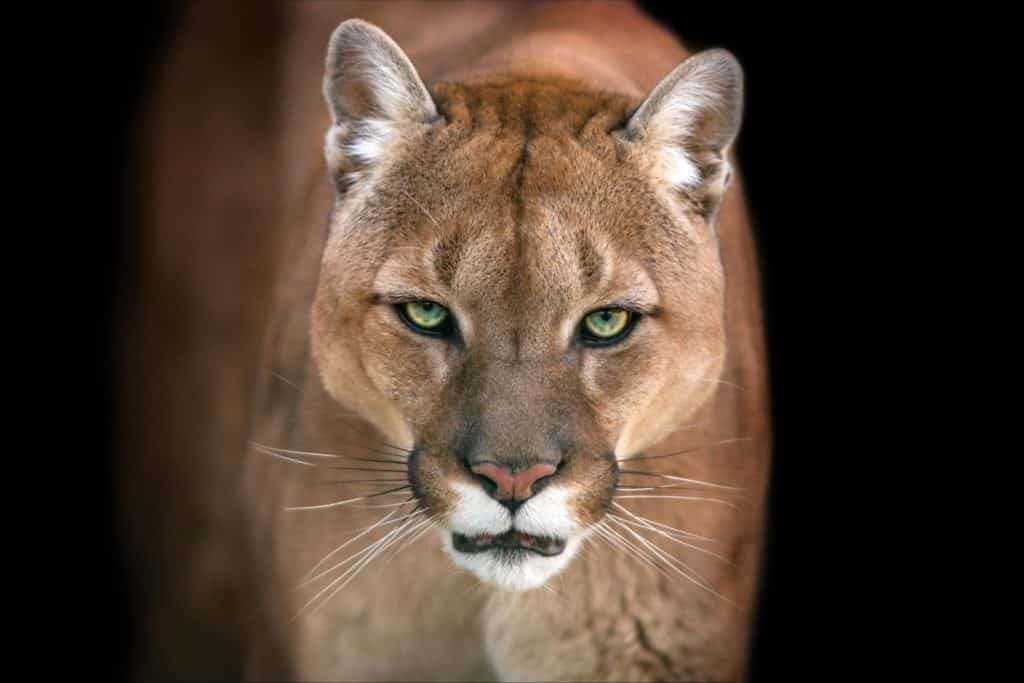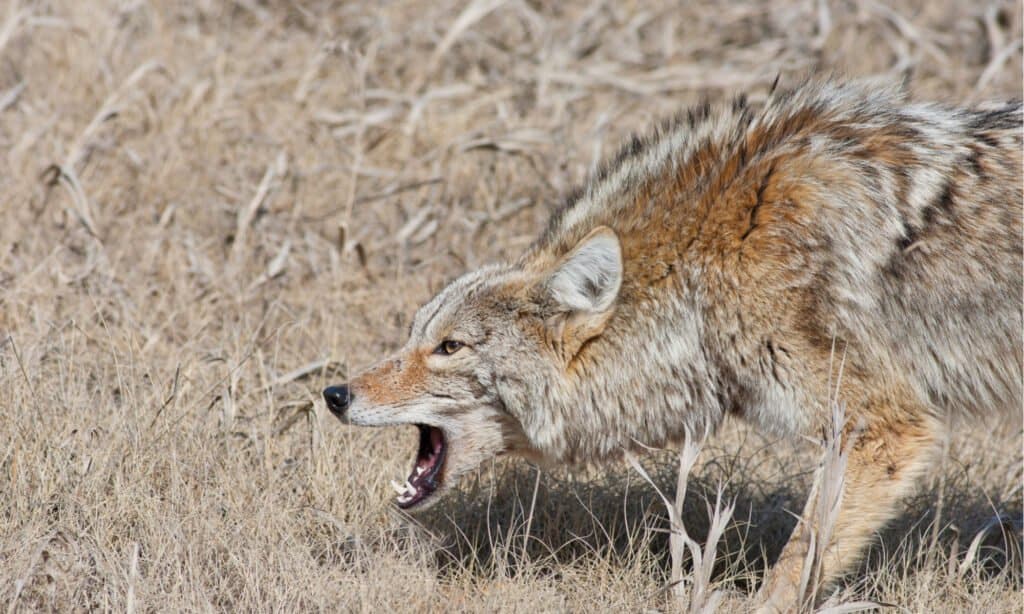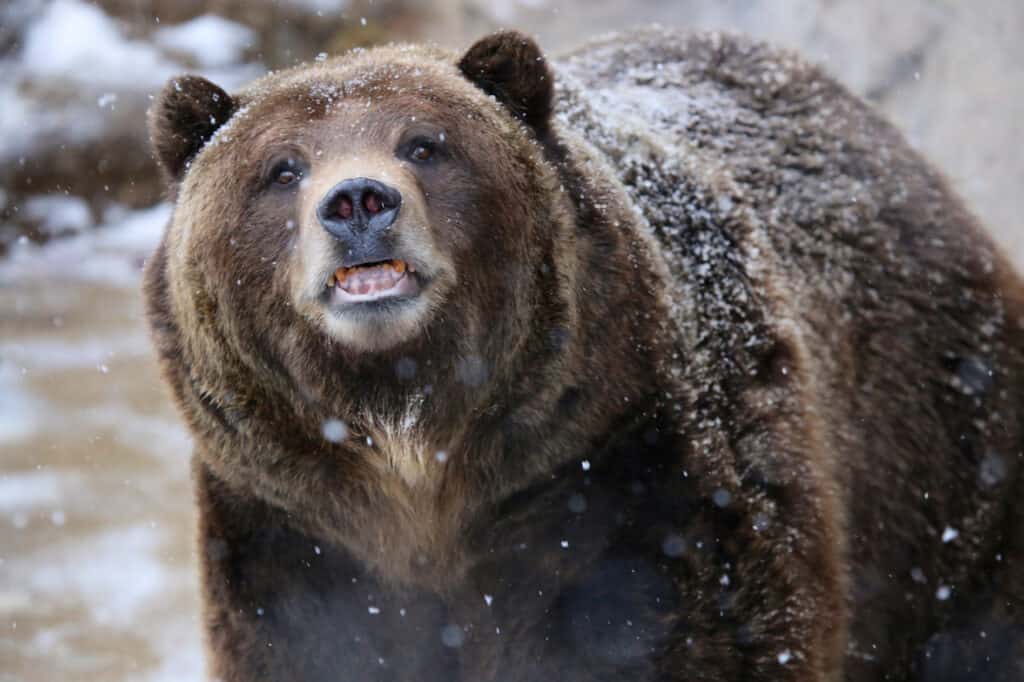Many carnivorous mammals can be found in the United States. Mountain lions and coyotes are two such creatures that farmers and people living in rural areas fear. Both are deadly predators that make their presence known with their howling and yowling. Since these two animals share a range, they’re bound to have run-ins with each other from time to time. If a mountain lion vs coyote fight happened, who would win? We’re going to take a look at these two animals and see which of them is better poised to win a fight against the other.
Comparing a Mountain Lion and a Coyote

| Mountain Lion | Coyote | |
|---|---|---|
| Size | Weight: 60lbs-130lbs Length: 5ft-8ft Height: 2ft-3ft at the shoulder | Weight: 15lbs – 45lbs Length: 2.5ft-2.9ft Height: 2ft-2.2ft at the shoulder |
| Speed | – 30 mph | – 35-40 mph |
| Defenses | – Speed – Large size – Good senses | – Speed – Senses helps it avoid trouble |
| Offensive Capabilities | – Powerful biting force of 1311 N – Very powerful jaws – 2-inch-long canines – 2.5-inch claws | 681 N bite power – 42 teeth – 1.5-inch-long canines – Teeth used to grip and tear enemies |
| Predatory Behavior | – Ambush predator that wraps its forelegs around prey and takes them to the ground – Very quiet hunters that stalk potential prey before attacking | – Ambush predators when hunting alone – Hunt in packs for large prey using persistence predation |
What Are Key Differences Between a Mountain Lion and a Coyote?

The mountain
lion
goes by many names like the cougar and puma, but it’s just as deadly no matter what you call it.
©Kwadrat/Shutterstock.com
The greatest differences between a mountain lion and a coyote are their scientific families and sizes. The mountain lion is a large cat from the Felis family, weighs up to 130lbs, and grows about 8ft long. The coyote is a medium-sized canine from the Canis family that weighs up to 45lbs and grows about 3ft long, excluding its tail.
The morphological differences between these animals are substantial and will impact this fight. After all, the coyote is similar to a small wolf, and the mountain lion is sometimes counted as one of the big cats that hunt and terrorize prey around the world. Still, we need to examine additional factors to crown a winner. Let’s take a look at other valuable pieces of the puzzle that will affect this battle.
What Are the Key Factors in a Fight Between a Mountain Lion and a Coyote?

Coyotes can be vicious predators with great speed.
©Brenda Carson/Shutterstock.com
The most important factors in a battle between mountain lions and coyotes are similar to other battles within the animal kingdom. We must examine the size, speed, and how the creatures attack their prey. These are just some of the most important elements we must compare, though.
We would also take a look at how the animals measure up in terms of defenses and predation styles, too. By the time we’re finished, we’ll know which of these animals is destined to overcome the other.
Mountain Lion vs Coyote: Size
Mountain lions are much larger than coyotes. The average mountain lion weighs between 60lbs and 130lbs, stands 2ft-3ft tall at the shoulder, and grows up to 8ft long. The largest mountain lion weighed over 270lbs.
The coyote only weighs between 15lbs and 45lbs, stands just over 2ft tall, and grows less than 3ft long. This canid is much smaller than its feline adversary.
Mountain lions have a size advantage.
Mountain Lion vs Coyote: Speed and Movement
Coyotes are faster than mountain lions. These mammals can reach speeds between 35 and 40 mph. That means they can leave mountain lions in the dust in a battle of sheer speed. After all, mountain lions can only run at about 30 mph.
Coyotes have a significant speed advantage over mountain lions.
Mountain Lion vs Coyote: Defenses
Coyotes don’t have much in the way of defenses as individuals. They have the speed to get away from trouble and senses to alert them to the presence of danger. They also live and sometimes hunt in packs, giving them an advantage over their foes.
Mountain lions have their speed, senses, and size to keep them safe. It also helps that their threat display includes a positively terrifying growl, a sound sure enough to keep away many threats.
Coyotes have better defenses than mountain lions as a group, but they are equal as individuals.
Mountain Lion vs Coyote: Offensive Capabilities
Coyotes have a strong bite, 1.5-inch teeth, and the power to grab ahold of prey and tear their flesh. These animals use their speed to strike. They prefer to harry and use their endurance to take down larger animals, but they will opt to take down small ones with a single bite.
Mountain lions use their size and power to completely overwhelm foes before they know what’s happening. These massive cats have a more powerful bite than a coyote, with 2-inch-long teeth and 2.5-inch-long claws. They prefer to end the fight in one swift, deadly strike.
Mountain lions are better suited to fight with a more offensive weapon than coyotes.
Mountain Lion vs Coyote: Predatory Behaviors
Coyotes are ambush predators when hunting alone, but they are persistent hunters when hunting in packs. They are most successful when hunting small prey. In those cases, they only need to grab the prey by the throat and bring it to the ground. Persistent hunting with a pack often yields success, but an unsuccessful hunt wastes much energy.
Mountain lions are ambush predators. They hunt alone, and they have a specific technique. They will stalk and then ambush their prey, wrapping their paws around them and taking them to the ground while simultaneously landing a massive bite to the throat or skull.
The mountain lion has a far more effective predatory behavior.
Who Would Win in a Fight Between a Mountain Lion and a Coyote?

Mountain lions are poised to win, with their long teeth and strong claws.
A mountain lion would win a fight against a coyote. It has the size, power, and ability to kill a lone coyote. The fight could start with the mountain lion stalking the coyote and swiftly ending the fight with one decisive ambush.
However, we’re going to imagine the best-case scenario for the coyote. The two animals meet on open ground. The coyote uses its speed and agility to snap at the mountain lion, which waits patiently and swats at the annoying animal. The coyote moves in for another attack, and the mountain lion springs forth and wraps its forelegs and digs in with its claws.
The fight is over as the mountain lion attacks the smaller animal’s neck and head, ending the battle. The battle would be a blur of teeth and fur, but it would end with a satisfied mountain lion standing over a dead coyote.
What Animal Can Take Down a Mountain Lion?

A mountain lion would be outmatched by a grizzly which has a greater bite force and the ability to deliver blows of over 800 lbs
©Steve Boice/Shutterstock.com
Grizzlies: A case of deceiving appearances, these adorable, outsized furballs sit at the very top of the food chain in any habitat they occupy.
It’s easy to see why with their ability to reach 9 feet in height and weigh a whopping 2,000 lbs. There is also their bite force range of 975 and 1,160 psi, not to mention their ability to heft 1,000 lbs. So that when you factor in their razor-sharp claws and their ability to deliver blows of over 800 lbs, things start to look rather grim for the puma.
Agility, sharp reflexes, and keen eyesight notwithstanding, it is pretty easy to understand why these felines prefer to give these apex predators a wide berth, even when they might sneak up on other carnivores such as a lone wolf, on occasion, with vengeance on their minds.
Especially since all it would take is a single well-aimed blow to bring the cougar to its knees.
The photo featured at the top of this post is © Scott E Read/Shutterstock.com
Thank you for reading! Have some feedback for us? Contact the AZ Animals editorial team.






